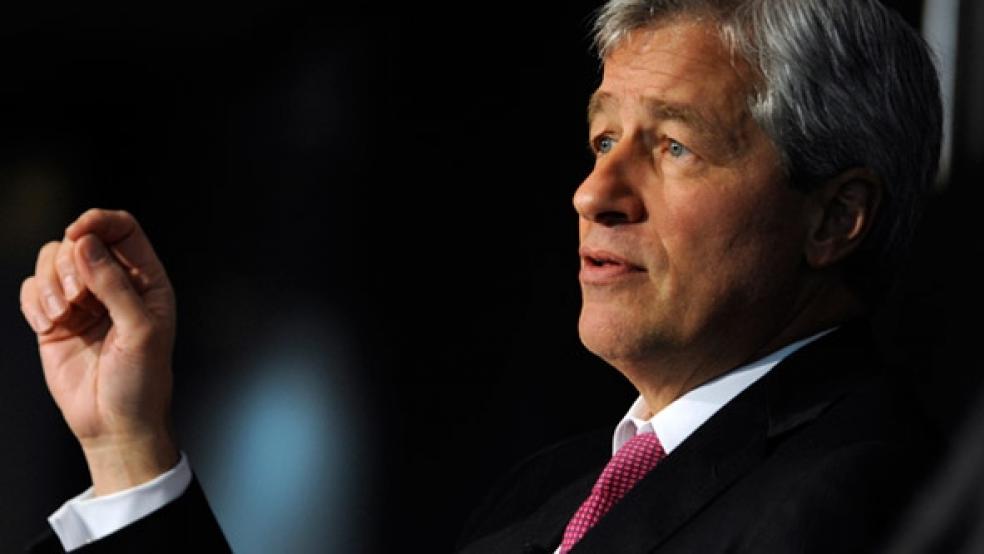That clanging sound you just heard was Jamie Dimon’s halo falling to the floor.
Dimon and his firm, JPMorgan Chase (JPM), seemingly couldn’t make a wrong step for years, even during the worst of the financial crisis. As other banks blew up, Dimon’s reputation was burnished and JPMorgan became the model for risk management on Wall Street. The firm, once known as the “The House of Morgan,” was dubbed “The House of Dimon” in recognition of that fact.
But that immunity came to a crashing halt yesterday, when Dimon held a conference call to reveal that the bank had taken a $2 billion trading loss in the last six weeks – and that it may end up reporting another $1 billion in losses this month as the volatile markets make closing out some of those positions very costly. The culprit? Derivatives bets using credit default swaps on a portfolio of corporate debt. “They were egregious mistakes; they were self-inflicted,” Dimon admitted during the relatively brief conference call. The trade wasn’t just complex but also “flawed” and “poorly reviewed.”
RELATED: Banks Play the Liquidity Card to Kill Real Reform
Dimon apologized profusely, particularly to analysts he had met with in recent days and whom he couldn’t inform of what was going on for legal reasons. He also took responsibility for the losses, and warned against drawing too sweeping a conclusion from it. “Just because we were stupid, doesn’t mean anyone else was.”
The problem is that apologies and humility after the fact aren’t enough. Nor is it good enough for the bank to decide that the “value-at-risk” model it once saw as the ne plus ultra of risk management isn’t adequate and announce it will be reverting to an older strategy for trying to identify excessively risky activities before they blow up in the face of the institution.
What every CEO knows – and Dimon probably knows better than most – is that the only effective way to handle a crisis of this magnitude is to avoid it in the first place. A postmortem will undoubtedly reveal all kinds of flaws in how the bank oversaw the activities of the London trader whom the Wall Street Journal has indicated was responsible for the disastrous strategy. But shareholders still will be stuck with a loss of at least $2 billion and possibly $3 billion or more.
Whether it’s discovering a rogue trader like Nick Leeson of Barings Bank before he can bring down the institution, figuring out when models are flawed, as with Long-Term Capital Management and MF Global, or simply realizing that just because everyone else on Wall Street is loading up on subprime mortgages doesn’t mean it’s the smartest thing to do, there have been plenty of reminders of the perils of being a bank or investment firm these days. Someone within JPMorgan Chase should have been paying particular scrutiny to transactions of the sort that that have caused the bank’s losses. The 2008 financial crisis made it very clear that credit derivatives could be misused, causing losses; the Volcker Rule made it very clear to financial institutions that their proprietary trading would come under particularly intense scrutiny.
Dimon quipped that while the synthetic credit position didn’t violate the Volcker rule, it did violate “the Dimon Principle.” That makes it all the worse, on two fronts. First, if the bank’s internal standards are tougher than those regulators are battling the industry to impose, why didn’t they catch the problem before it became a crisis and a multi-billion-dollar loss? Dimon noted during the call that the strategy caused “small” losses during the first quarter; that should have caused a red flag to go up and for someone to ensure that “small” never stood a chance of becoming “big.” That’s what effective risk managers do. At first glance, it sounds as if either the bank’s risk managers either missed the problem altogether (in which case the bank’s judgment is flawed for hiring incompetent risk managers) or weren’t given the kind of access or power they needed to rein in the derivatives trades (in which case, shame on the bank again, this time for its unwillingness to give enough responsibility to those risk managers).
RELATED: JPMorgan: The Best of a Bad Banking Lot
When Dimon, a vocal critic of tighter Wall Street regulation, commented that the trading loss “plays right into the hands” of the Volcker Rule’s advocates, he was right. Indeed, it’s hard to think of a better example of why the Volcker Rule was crafted; in fact, this is the single best piece of evidence supporting it. Throughout the debate over the reform of the financial services industry, the common refrain was that proprietary trading, and bank investments in hedge funds and other such vehicles, had never caused losses for financial institutions, their shareholders, or the system. Well, now they have.
When a bank like “The House of Dimon” is too big to fail, its risk management either has to be flawless, or its risk-taking needs to be restricted. After-the-fact apologies – however welcome, within the context of an industry that tends to prefer explanations to mea culpas – simply aren’t enough. This was a $2 billion loss, incurred in only six weeks, at an institution that sailed through the crisis with hardly a scratch. What does that say about what might be taking place at other large institutions that can’t boast similarly rigorous risk management systems?
JPMorgan does possess what Dimon didn’t delay in pointing out is a “fortress balance sheet”: While the losses will put a dent in its capital, the bank is still sound and will survive this hullaballoo. So, too, will Dimon, in all likelihood. But the “egregious mistakes” for which he had to repent Thursday mean that it’s also very probable that the Volcker Rule – warts, unintended consequences and all – also will be around for the foreseeable future.






